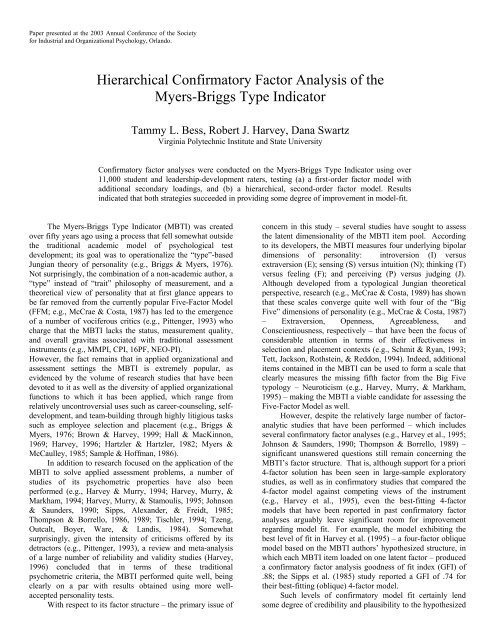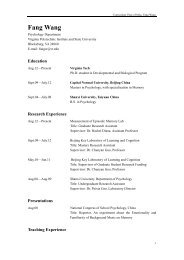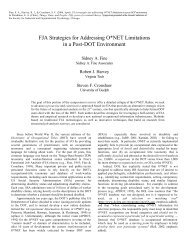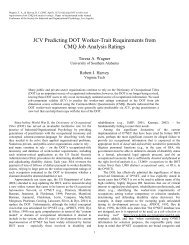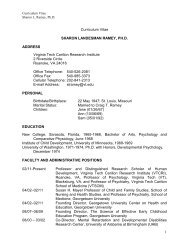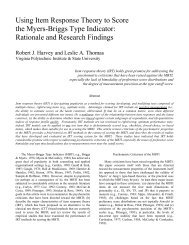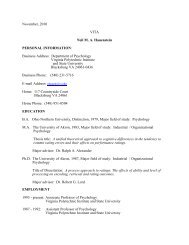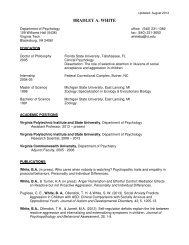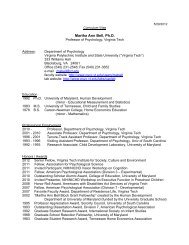Hierarchical Confirmatory Factor Analysis of the Myers-Briggs Type ...
Hierarchical Confirmatory Factor Analysis of the Myers-Briggs Type ...
Hierarchical Confirmatory Factor Analysis of the Myers-Briggs Type ...
Create successful ePaper yourself
Turn your PDF publications into a flip-book with our unique Google optimized e-Paper software.
Paper presented at <strong>the</strong> 2003 Annual Conference <strong>of</strong> <strong>the</strong> Society<br />
for Industrial and Organizational Psychology, Orlando.<br />
<strong>Hierarchical</strong> <strong>Confirmatory</strong> <strong>Factor</strong> <strong>Analysis</strong> <strong>of</strong> <strong>the</strong><br />
<strong>Myers</strong>-<strong>Briggs</strong> <strong>Type</strong> Indicator<br />
Tammy L. Bess, Robert J. Harvey, Dana Swartz<br />
Virginia Polytechnic Institute and State University<br />
<strong>Confirmatory</strong> factor analyses were conducted on <strong>the</strong> <strong>Myers</strong>-<strong>Briggs</strong> <strong>Type</strong> Indicator using over<br />
11,000 student and leadership-development raters, testing (a) a first-order factor model with<br />
additional secondary loadings, and (b) a hierarchical, second-order factor model. Results<br />
indicated that both strategies succeeded in providing some degree <strong>of</strong> improvement in model-fit.<br />
The <strong>Myers</strong>-<strong>Briggs</strong> <strong>Type</strong> Indicator (MBTI) was created<br />
over fifty years ago using a process that fell somewhat outside<br />
<strong>the</strong> traditional academic model <strong>of</strong> psychological test<br />
development; its goal was to operationalize <strong>the</strong> “type”-based<br />
Jungian <strong>the</strong>ory <strong>of</strong> personality (e.g., <strong>Briggs</strong> & <strong>Myers</strong>, 1976).<br />
Not surprisingly, <strong>the</strong> combination <strong>of</strong> a non-academic author, a<br />
“type” instead <strong>of</strong> “trait” philosophy <strong>of</strong> measurement, and a<br />
<strong>the</strong>oretical view <strong>of</strong> personality that at first glance appears to<br />
be far removed from <strong>the</strong> currently popular Five-<strong>Factor</strong> Model<br />
(FFM; e.g., McCrae & Costa, 1987) has led to <strong>the</strong> emergence<br />
<strong>of</strong> a number <strong>of</strong> vociferous critics (e.g., Pittenger, 1993) who<br />
charge that <strong>the</strong> MBTI lacks <strong>the</strong> status, measurement quality,<br />
and overall gravitas associated with traditional assessment<br />
instruments (e.g., MMPI, CPI, 16PF, NEO-PI).<br />
However, <strong>the</strong> fact remains that in applied organizational and<br />
assessment settings <strong>the</strong> MBTI is extremely popular, as<br />
evidenced by <strong>the</strong> volume <strong>of</strong> research studies that have been<br />
devoted to it as well as <strong>the</strong> diversity <strong>of</strong> applied organizational<br />
functions to which it has been applied, which range from<br />
relatively uncontroversial uses such as career-counseling, selfdevelopment,<br />
and team-building through highly litigious tasks<br />
such as employee selection and placement (e.g., <strong>Briggs</strong> &<br />
<strong>Myers</strong>, 1976; Brown & Harvey, 1999; Hall & MacKinnon,<br />
1969; Harvey, 1996; Hartzler & Hartzler, 1982; <strong>Myers</strong> &<br />
McCaulley, 1985; Sample & H<strong>of</strong>fman, 1986).<br />
In addition to research focused on <strong>the</strong> application <strong>of</strong> <strong>the</strong><br />
MBTI to solve applied assessment problems, a number <strong>of</strong><br />
studies <strong>of</strong> its psychometric properties have also been<br />
performed (e.g., Harvey & Murry, 1994; Harvey, Murry, &<br />
Markham, 1994; Harvey, Murry, & Stamoulis, 1995; Johnson<br />
& Saunders, 1990; Sipps, Alexander, & Freidt, 1985;<br />
Thompson & Borrello, 1986, 1989; Tischler, 1994; Tzeng,<br />
Outcalt, Boyer, Ware, & Landis, 1984). Somewhat<br />
surprisingly, given <strong>the</strong> intensity <strong>of</strong> criticisms <strong>of</strong>fered by its<br />
detractors (e.g., Pittenger, 1993), a review and meta-analysis<br />
<strong>of</strong> a large number <strong>of</strong> reliability and validity studies (Harvey,<br />
1996) concluded that in terms <strong>of</strong> <strong>the</strong>se traditional<br />
psychometric criteria, <strong>the</strong> MBTI performed quite well, being<br />
clearly on a par with results obtained using more wellaccepted<br />
personality tests.<br />
With respect to its factor structure – <strong>the</strong> primary issue <strong>of</strong><br />
concern in this study – several studies have sought to assess<br />
<strong>the</strong> latent dimensionality <strong>of</strong> <strong>the</strong> MBTI item pool. According<br />
to its developers, <strong>the</strong> MBTI measures four underlying bipolar<br />
dimensions <strong>of</strong> personality: introversion (I) versus<br />
extraversion (E); sensing (S) versus intuition (N); thinking (T)<br />
versus feeling (F); and perceiving (P) versus judging (J).<br />
Although developed from a typological Jungian <strong>the</strong>oretical<br />
perspective, research (e.g., McCrae & Costa, 1989) has shown<br />
that <strong>the</strong>se scales converge quite well with four <strong>of</strong> <strong>the</strong> “Big<br />
Five” dimensions <strong>of</strong> personality (e.g., McCrae & Costa, 1987)<br />
– Extraversion, Openness, Agreeableness, and<br />
Conscientiousness, respectively – that have been <strong>the</strong> focus <strong>of</strong><br />
considerable attention in terms <strong>of</strong> <strong>the</strong>ir effectiveness in<br />
selection and placement contexts (e.g., Schmit & Ryan, 1993;<br />
Tett, Jackson, Rothstein, & Reddon, 1994). Indeed, additional<br />
items contained in <strong>the</strong> MBTI can be used to form a scale that<br />
clearly measures <strong>the</strong> missing fifth factor from <strong>the</strong> Big Five<br />
typology – Neuroticism (e.g., Harvey, Murry, & Markham,<br />
1995) – making <strong>the</strong> MBTI a viable candidate for assessing <strong>the</strong><br />
Five-<strong>Factor</strong> Model as well.<br />
However, despite <strong>the</strong> relatively large number <strong>of</strong> factoranalytic<br />
studies that have been performed – which includes<br />
several confirmatory factor analyses (e.g., Harvey et al., 1995;<br />
Johnson & Saunders, 1990; Thompson & Borrello, 1989) –<br />
significant unanswered questions still remain concerning <strong>the</strong><br />
MBTI’s factor structure. That is, although support for a priori<br />
4-factor solution has been seen in large-sample exploratory<br />
studies, as well as in confirmatory studies that compared <strong>the</strong><br />
4-factor model against competing views <strong>of</strong> <strong>the</strong> instrument<br />
(e.g., Harvey et al., 1995), even <strong>the</strong> best-fitting 4-factor<br />
models that have been reported in past confirmatory factor<br />
analyses arguably leave significant room for improvement<br />
regarding model fit. For example, <strong>the</strong> model exhibiting <strong>the</strong><br />
best level <strong>of</strong> fit in Harvey et al. (1995) – a four-factor oblique<br />
model based on <strong>the</strong> MBTI authors’ hypo<strong>the</strong>sized structure, in<br />
which each MBTI item loaded on one latent factor – produced<br />
a confirmatory factor analysis goodness <strong>of</strong> fit index (GFI) <strong>of</strong><br />
.88; <strong>the</strong> Sipps et al. (1985) study reported a GFI <strong>of</strong> .74 for<br />
<strong>the</strong>ir best-fitting (oblique) 4-factor model.<br />
Such levels <strong>of</strong> confirmatory model fit certainly lend<br />
some degree <strong>of</strong> credibility and plausibility to <strong>the</strong> hypo<strong>the</strong>sized
4-factor structure, especially given <strong>the</strong> fact that <strong>the</strong> competing<br />
factor models specifying alternative dimensionalities tested in<br />
Harvey et al. (1995) were found to provide clearly inferior<br />
levels <strong>of</strong> fit in comparison to <strong>the</strong> a priori model. However, <strong>the</strong><br />
fact remains that if conventional rules-<strong>of</strong>-thumb for<br />
interpreting GFI and similar model-fit statistics are applied<br />
(e.g., viewing fit indices in <strong>the</strong> .90’s as desirable; see James,<br />
Mulaik, & Brett, 1992; Tucker & Lewis, 1973), one is left<br />
with <strong>the</strong> conclusion that <strong>the</strong> available research has yet to<br />
conclusively determine <strong>the</strong> answers to such basic questions as<br />
<strong>the</strong> number <strong>of</strong> factors that <strong>the</strong> MBTI measures, and <strong>the</strong> item<br />
makeup <strong>of</strong> each.<br />
Our study attempted to address <strong>the</strong>se questions by<br />
evaluating <strong>the</strong> degree to which two strategies for developing<br />
alternative factor models to represent <strong>the</strong> MBTI’s latent<br />
structure might be successful in improving <strong>the</strong> fit <strong>of</strong><br />
confirmatory factor analysis models, relative to <strong>the</strong> levels <strong>of</strong><br />
fit seen in <strong>the</strong> best-fitting, a priori 4-factor model examined in<br />
earlier confirmatory studies. Ideally, one (or both) <strong>of</strong> <strong>the</strong>se<br />
methods for developing new models <strong>of</strong> <strong>the</strong> MBTI’s factor<br />
structure would be successful in increasing <strong>the</strong> levels <strong>of</strong><br />
confirmatory factor analysis model-fit into <strong>the</strong> range generally<br />
viewed as desirable. Because it is clearly inappropriate to<br />
develop, <strong>the</strong>n subsequently “confirm,” a factor model using a<br />
single sample <strong>of</strong> respondents, we conducted our modeldevelopment<br />
versus model-testing analyses in separate<br />
samples <strong>of</strong> raters drawn from both student and “real world”<br />
populations <strong>of</strong> organizational employees.<br />
The first strategy for developing alternative factor<br />
models focused on freeing-up additional factor loadings, using<br />
<strong>the</strong> a priori 4-factor pattern hypo<strong>the</strong>sized by <strong>the</strong> MBTI’s<br />
developers as <strong>the</strong> starting point. That is, after failing to find<br />
convincing levels <strong>of</strong> model fit (using conventional rules-<strong>of</strong>thumb)<br />
in a confirmatory test <strong>of</strong> <strong>the</strong> 4-factor model, Harvey et<br />
al. (1995) conducted an additional round <strong>of</strong> exploratory factor<br />
analyses on <strong>the</strong> same dataset, which produced results that<br />
suggested that it might be beneficial to add a number <strong>of</strong><br />
secondary factor loadings as a means to improve model fit.<br />
Although some test developers believe strongly in <strong>the</strong> doctrine<br />
<strong>of</strong> independent-cluster structure – i.e., that each item should<br />
load on one and only one latent factor – it is probably<br />
unreasonable to expect that an independent-cluster structure<br />
would obtain in an instrument like <strong>the</strong> MBTI, in which a<br />
relatively large number <strong>of</strong> items load on a relatively small<br />
number <strong>of</strong> latent factors (e.g., in <strong>the</strong> MBTI Form F/G scoring<br />
system, on average over 23 items are used to measure each <strong>of</strong><br />
<strong>the</strong> four primary scales). Accordingly, we hypo<strong>the</strong>sized that<br />
<strong>the</strong> addition <strong>of</strong> secondary loadings might be sufficient to<br />
produce appreciable improvements in confirmatory model-fit<br />
indices. Exploratory factor analysis results (using both <strong>the</strong><br />
Harvey et al. sample, as well as a new sample <strong>of</strong> raters drawn<br />
from participants in leadership-development programs) were<br />
used to generate <strong>the</strong> secondary loading patterns, which were<br />
<strong>the</strong>n tested using confirmatory factor analysis in a holdout<br />
sample <strong>of</strong> leadership-program raters.<br />
The second strategy for improving model-fit levels<br />
involved <strong>the</strong> estimation <strong>of</strong> a hierarchical, second-order factor<br />
model for <strong>the</strong> MBTI. In contrast to previous confirmatory<br />
item-level factor analyses <strong>of</strong> <strong>the</strong> MBTI that estimated only<br />
first-order latent factors (e.g., Harvey et al., 1995; Sipps et al.,<br />
1985) for <strong>the</strong> 94-item Form F item pool, we explored <strong>the</strong><br />
possibility that a model that estimated (a) a number <strong>of</strong> firstorder<br />
subfactors (or facets) <strong>of</strong> each <strong>of</strong> <strong>the</strong> four primary MBTI<br />
dimensions, as well as (b) four second-order factors to<br />
represent <strong>the</strong> primary MBTI scales on which <strong>the</strong> first-order<br />
facets would load, could produce higher levels <strong>of</strong> model fit.<br />
Support for <strong>the</strong> view that a hierarchical approach might be<br />
necessary can be found in <strong>the</strong> results <strong>of</strong> Johnson and Saunders<br />
(1990), who conducted a factor analysis that attempted to<br />
group <strong>the</strong> subscales formed by <strong>the</strong> <strong>Type</strong> Differentiation<br />
Indicator (TDI) scoring system (Saunders, 1986) for <strong>the</strong> 290-<br />
item MBTI Form J into <strong>the</strong> four primary MBTI dimensions;<br />
<strong>the</strong>ir results suggested that <strong>the</strong> TDI subscales could indeed be<br />
grouped into <strong>the</strong> predicted 4-factor structure. Although<br />
Johnson and Saunders only studied subscale-level composite<br />
scores for each <strong>of</strong> <strong>the</strong>se facets (i.e., <strong>the</strong>y did not include actual<br />
item-level data in <strong>the</strong>ir confirmatory analysis), <strong>the</strong>ir results<br />
imply that it may be necessary to model both <strong>the</strong> overall 4-<br />
factor structure <strong>of</strong> <strong>the</strong> MBTI, as well as <strong>the</strong> subfactors or<br />
facets <strong>of</strong> each <strong>of</strong> those four domains, in order to achieve<br />
acceptable levels <strong>of</strong> model fit when performing confirmatory<br />
factor analysis using item-level MBTI data.<br />
Participants<br />
Method<br />
The MBTI responses that were analyzed in this study<br />
were obtained from two archival sources. To perform <strong>the</strong><br />
exploratory “model-building” factor analyses needed to<br />
identify <strong>the</strong> secondary factor loadings for <strong>the</strong> 4-factor firstorder<br />
models, and <strong>the</strong> higher-dimensionality first-order<br />
portions <strong>of</strong> <strong>the</strong> hierarchical factor model (i.e., <strong>the</strong> subfactors <strong>of</strong><br />
each <strong>of</strong> <strong>the</strong> four MBTI item pools), we studied (a) a sample <strong>of</strong><br />
2,639 raters composed <strong>of</strong> individuals (primarily undergraduate<br />
students) used in <strong>the</strong> Harvey et al. (1995) and Harvey and<br />
Murry (1994) studies, keeping only respondents with no<br />
missing data across <strong>the</strong> 94 items from Form F that are scored<br />
to produce <strong>the</strong> four main scales; and (b) one-half (N = 4,313)<br />
<strong>of</strong> a sample <strong>of</strong> raters who participated in leadership<br />
development programs held by <strong>the</strong> Center for Creative<br />
Leadership (CCL), again using only pr<strong>of</strong>iles with no missing<br />
item responses across <strong>the</strong> four primary MBTI scales.<br />
For <strong>the</strong> confirmatory analyses, <strong>the</strong> holdout sample (N =<br />
4,244) <strong>of</strong> CCL raters was used to test <strong>the</strong> new factor models.<br />
Although subjects from <strong>the</strong> Harvey et al. (1995) and Harvey<br />
and Murry (1994) studies were re-used during <strong>the</strong> “modelbuilding”<br />
stage <strong>of</strong> our study, we did not view this as<br />
constituting a problem, given that <strong>the</strong>se raters were used only<br />
to develop (and not to test) <strong>the</strong> new factor models, and<br />
because we additionally used a second, independent sample<br />
(<strong>the</strong> first half <strong>of</strong> <strong>the</strong> CCL database) as a basis for generating<br />
new factor models to be tested in <strong>the</strong> confirmatory analyses.<br />
None <strong>of</strong> <strong>the</strong> raters in <strong>the</strong> CCL samples were previously used<br />
to ei<strong>the</strong>r develop or test confirmatory factor models <strong>of</strong> <strong>the</strong><br />
MBTI.<br />
Materials and Models<br />
Form F <strong>of</strong> <strong>the</strong> MBTI was used, which contains 166<br />
multiple-choice items. Of <strong>the</strong>se 166 items, 95 items make up
<strong>the</strong> four dimension scores under <strong>the</strong> Form F/G scoring system.<br />
Ninety-four items were analyzed in <strong>the</strong> present study; item 68<br />
was omitted because it allows raters <strong>the</strong> option <strong>of</strong> selecting<br />
more than one response alternative. Because we could not<br />
rely on <strong>the</strong> TDI scoring system (Saunders, 1986) used by<br />
Johnson and Saunders (1990) in order to develop our<br />
hypo<strong>the</strong>sized hierarchical model (i.e., because many <strong>of</strong> <strong>the</strong><br />
items that are scored in Form J to produce <strong>the</strong> TDI facet scales<br />
are not present in <strong>the</strong> shorter, and more widely used, Forms<br />
F/G), we relied on exploratory factor analyses <strong>of</strong> <strong>the</strong> Form F<br />
item pools (conducted separately in each <strong>of</strong> <strong>the</strong> four main<br />
scales) to generate <strong>the</strong> first-order subfactors. Given <strong>the</strong><br />
demographic dissimilarities in <strong>the</strong> student versus CCL<br />
samples, <strong>the</strong> similarity <strong>of</strong> exploratory models derived in <strong>the</strong><br />
different samples was <strong>of</strong> interest.<br />
Procedure<br />
For <strong>the</strong> exploratory analyses, data were analyzed using<br />
SAS version 8; exploratory factor analyses were performed<br />
using PROC FACTOR, with oblique Harris-Kaiser rotation<br />
(power = 0.5) and squared multiple correlations as<br />
communality estimates. The rotated 4-factor pattern was <strong>the</strong>n<br />
examined for additional (secondary) item loadings. For <strong>the</strong><br />
hierarchical models, subfactors were identified by examining<br />
solutions suggested by scree plots <strong>of</strong> eigenvalues, using <strong>the</strong><br />
criterion <strong>of</strong> interpretability and robustness (i.e., having a<br />
reasonable number <strong>of</strong> items for each factor) to define <strong>the</strong> final<br />
facet scales selected for <strong>the</strong> model-building.<br />
For <strong>the</strong> confirmatory factor models, PROC CALIS was<br />
used on <strong>the</strong> item variance-covariance matrix; <strong>the</strong> GFI,<br />
adjusted GFI, root mean square residual (RMSR), Bentler’s<br />
comparative fit index (CFI), and James, Mulaik, and Brett’s<br />
parsimonious normed fit index (NFI) were used to quantify<br />
model fit. In addition to <strong>the</strong> alternative models developed<br />
here, we also evaluated <strong>the</strong> fit <strong>of</strong> <strong>the</strong> a priori 4-factor models<br />
(i.e., <strong>the</strong> orthogonal and oblique independent-cluster structure<br />
models from Harvey et al., 1995) in order to provide a basis <strong>of</strong><br />
comparison to <strong>the</strong> earlier results.<br />
Model Building<br />
Results<br />
Figures 1-5 present <strong>the</strong> scree plots for <strong>the</strong> overall 94-item<br />
pools, and each <strong>of</strong> <strong>the</strong> four major scales analyzed separately;<br />
Table 1 summarizes <strong>the</strong> exploratory factor analysis results.<br />
As in previous studies, <strong>the</strong> scree plots for <strong>the</strong> full 94-item pool<br />
(Figure 1) are quite clear in indicating that <strong>the</strong>se MBTI items<br />
function as indicators <strong>of</strong> four primary latent constructs.<br />
Likewise, <strong>the</strong> factor analyses performed in <strong>the</strong> four separate<br />
item pools (Figures 2-5) are equally clear in indicating that<br />
each pool is dominated by a single underlying latent trait (e.g.,<br />
considering <strong>the</strong> size <strong>of</strong> <strong>the</strong> first eigenvalue, and <strong>the</strong> ratios <strong>of</strong><br />
first to second eigenvalues). Interestingly, given <strong>the</strong><br />
presumably significant demographic and motivational<br />
differences in existence between <strong>the</strong> student versus CCL<br />
samples, <strong>the</strong> results in Figures 1-5 are strikingly similar in<br />
terms <strong>of</strong> <strong>the</strong> eigenvalue patterns <strong>the</strong>y reveal.<br />
- - - - - - - - - - - - - - - - - - - - - - - - - - -<br />
Insert Figures 1-5 and Table 1 about here<br />
- - - - - - - - - - - - - - - - - - - - - - - - - - -<br />
With respect to finding secondary factor loadings that<br />
could be added to <strong>the</strong> a priori 4-factor solution in an attempt to<br />
improve model fit, <strong>the</strong> rotated factor loadings in Table 1 for<br />
<strong>the</strong> entire 94-item factor analyses reveal remarkably similar<br />
patterns <strong>of</strong> findings in <strong>the</strong> student versus CCL samples. Some<br />
sample-based differences were observed, however, leading us<br />
to examine two types <strong>of</strong> models with secondary loadings: a<br />
model with an additional 29 secondary-loading items from <strong>the</strong><br />
student sample, and one with 27 additional loadings based on<br />
<strong>the</strong> CCL sample (a cut<strong>of</strong>f <strong>of</strong> approximately .15 and higher was<br />
used to identify <strong>the</strong> non-predicted secondary loadings). Of <strong>the</strong><br />
four MBTI scales, secondary loadings were more numerous in<br />
<strong>the</strong> SN and JP domains, and it is typically quite easy to<br />
explain why <strong>the</strong>se items exhibit secondary loadings (e.g., item<br />
DN64, which deals with preferring to analyze unsolved<br />
problems, loads on both <strong>the</strong> “intuitive” pole <strong>of</strong> <strong>the</strong> SN scale as<br />
well <strong>the</strong> “thinking” pole <strong>of</strong> <strong>the</strong> TF factor).<br />
Regarding <strong>the</strong> analyses designed to identify<br />
subfactors/facets <strong>of</strong> each <strong>of</strong> <strong>the</strong> four main MBTI scales, <strong>the</strong><br />
results in Figures 2-5 and Table 1 again reveal highly similar<br />
results in <strong>the</strong> two samples; based on interpretability and<br />
parsimony, we chose 3-factor EI, 2-factor SN, 2-factor TF,<br />
and 3-factor JP solutions for both samples. Although<br />
interpretatively similar subfactors are seen in <strong>the</strong> student<br />
versus CCL samples, some differences are present (see Table<br />
1); consequently, separate confirmatory models were<br />
estimated in <strong>the</strong> holdout CCL sample based on <strong>the</strong> specific<br />
derivation sample (i.e., CCL versus student) that was used to<br />
generate <strong>the</strong> model.<br />
Model Testing<br />
Table 2 summarizes <strong>the</strong> model-fit statistics for <strong>the</strong><br />
confirmatory models that were estimated in <strong>the</strong> CCL holdout<br />
sample based on <strong>the</strong> above exploratory factor analysis results.<br />
Models 1 and 2 (a priori 4-factor without secondary loadings)<br />
were estimated in order to provide comparability to <strong>the</strong><br />
Harvey et al. (1995) results; interestingly, <strong>the</strong> orthogonal 4-<br />
factor a priori model fit appreciably better in this sample than<br />
in <strong>the</strong> Harvey et al. (1995) student-based sample, whereas <strong>the</strong><br />
oblique model fit slightly worse (earlier GFIs = .77 and .88,<br />
respectively).<br />
- - - - - - - - - - - - - - - - - - - - - - - - - - -<br />
Insert Table 2 about here<br />
- - - - - - - - - - - - - - - - - - - - - - - - - - -<br />
In terms <strong>of</strong> <strong>the</strong> ability <strong>of</strong> <strong>the</strong> strategy <strong>of</strong> adding secondary<br />
loadings to improve model fit, <strong>the</strong> results in Table 2 indicate<br />
that, relative to models 1-2, models 3-4 and 5-6 were<br />
somewhat successful; however, <strong>the</strong> magnitude <strong>of</strong><br />
improvement is modest (e.g., GFIs <strong>of</strong> approximately .88<br />
versus .85), and as in <strong>the</strong> earlier confirmatory MBTI factor<br />
analyses, none <strong>of</strong> <strong>the</strong> fit indices reach <strong>the</strong> .90-and-above range<br />
that many researchers deem indicative <strong>of</strong> adequate fit. As<br />
with <strong>the</strong> a priori 4-factor results (models 1-2), <strong>the</strong> addition <strong>of</strong><br />
oblique factors produced only a slight improvement in model<br />
fit relative to <strong>the</strong> orthogonal model (consistent with earlier<br />
factor analyses <strong>of</strong> <strong>the</strong> MBTI, only <strong>the</strong> SN and JP scales<br />
demonstrate appreciable levels <strong>of</strong> factor correlation: e.g., r =<br />
.39 in models 5-6, and r = .51 in model 2).
Regarding <strong>the</strong> second strategy <strong>of</strong> taking a hierarchical<br />
approach to improving model fit, models 7-8 represent a fully<br />
oblique (at <strong>the</strong> first-order factor level) representation <strong>of</strong> <strong>the</strong><br />
subfactor-based models developed using <strong>the</strong> student and CCL<br />
(derivation) samples, whereas models 9-10 represent <strong>the</strong> more<br />
restricted (hierarchical) case in which <strong>the</strong> first-order<br />
(subscale) MBTI factors are grouped to form <strong>the</strong> four secondorder<br />
MBTI domains. In this type <strong>of</strong> analysis, <strong>the</strong> fully<br />
oblique first-order facet models (7-8) can be interpreted as<br />
providing <strong>the</strong> best possible level <strong>of</strong> fit for any hierarchical<br />
MBTI model that is based on <strong>the</strong> linkages <strong>of</strong> MBTI items to<br />
first-order factors depicted in Table 1 (barring model<br />
modifications that we would consider unacceptable, such as<br />
allowing correlated unique factors); thus, <strong>the</strong> main issues<br />
concern <strong>the</strong> degree to which (a) <strong>the</strong> fit <strong>of</strong> <strong>the</strong> models with four<br />
second-order factors (9-10) is degraded relative to <strong>the</strong><br />
corresponding models 7-8, and (b) <strong>the</strong> fit <strong>of</strong> <strong>the</strong> hierarchical<br />
models is comparable to <strong>the</strong> fit produced by augmenting <strong>the</strong><br />
first-order 4-factor model with secondary loadings.<br />
As <strong>the</strong> results in Table 2 indicate, although <strong>the</strong> fullyoblique<br />
first-order facet models (7-8) produce <strong>the</strong> highest<br />
levels <strong>of</strong> model fit attained by any <strong>of</strong> our confirmatory factor<br />
solutions, and <strong>the</strong> restricted second-order 4-factor models (9-<br />
10) produce fit levels that are quite comparable to those<br />
produced by <strong>the</strong> fully-oblique first-order facet models (7-8),<br />
<strong>the</strong> fact remains that all <strong>of</strong> our alternative models produce fit<br />
indices that are generally quite similar to one ano<strong>the</strong>r<br />
(although <strong>the</strong>y all provide some degree <strong>of</strong> improvement over<br />
<strong>the</strong> a priori 4-factor model), and none achieve <strong>the</strong> .90-andhigher<br />
levels that are commonly viewed as denoting adequate<br />
fit.<br />
Discussion<br />
The results reported above indicate that our two-pronged<br />
strategy for using exploratory, model-building methods to<br />
produce alternative confirmatory factor models having<br />
increased levels <strong>of</strong> fit was, at least numerically, successful;<br />
fur<strong>the</strong>rmore, our findings clearly supported <strong>the</strong> view that <strong>the</strong><br />
94-item Form F/G MBTI item pool is dominated by <strong>the</strong> 4-<br />
factor structure predicted by <strong>the</strong> instrument’s authors (which,<br />
as was noted earlier, also matches up well with <strong>the</strong> four non-<br />
Neuroticism factors <strong>of</strong> <strong>the</strong> Big Five taxonomy). The fact that<br />
this a priori factor structure was yet again recovered via<br />
exploratory means and found to fit reasonably well using<br />
confirmatory analysis, in a sample <strong>of</strong> “real world” managerial<br />
employees that is arguably quite different from <strong>the</strong> collegestudent<br />
based samples that have been seen in earlier<br />
confirmatory and exploratory factor analyses, speaks directly<br />
to <strong>the</strong> robustness and generalizability <strong>of</strong> past claims <strong>of</strong> support<br />
for <strong>the</strong> predicted 4-factor MBTI latent structure.<br />
However, none <strong>of</strong> our confirmatory factor models<br />
succeeded in breaking <strong>the</strong> magical “.90 barrier” <strong>of</strong> fit, despite<br />
<strong>the</strong> fact that we aggressively sought out alternative models<br />
(using both <strong>the</strong> secondary-loadings and hierarchical factor<br />
structure strategies), derived <strong>the</strong> alternative models using both<br />
student and “real world” samples, and tested <strong>the</strong>m using<br />
confirmatory analysis in an independent holdout sample.<br />
Although additional research is needed to provide a definitive<br />
answer to this question, we hypo<strong>the</strong>size that this situation may<br />
well represent a case in which confirmatory model-fit indices<br />
computed for models involving large numbers <strong>of</strong> items, and<br />
relatively small numbers <strong>of</strong> factors, simply fail to provide a<br />
“practically useful” measure <strong>of</strong> model fit. That is, <strong>the</strong> models<br />
we tested possessed a very large number <strong>of</strong> overidentifying<br />
restrictions (i.e., degrees <strong>of</strong> freedom produced by <strong>the</strong> fact that<br />
many parameters, such as factor loadings or correlations<br />
between unique factors that could potentially have been<br />
estimated as free parameters, were instead fixed to zero),<br />
which provided us with tremendous power to reject <strong>the</strong><br />
implicit null hypo<strong>the</strong>sis that zero differences exist between <strong>the</strong><br />
variance/covariance matrix being analyzed, versus <strong>the</strong><br />
variance/covariance matrix implied by <strong>the</strong> estimated model<br />
parameters.<br />
In essence, ra<strong>the</strong>r than being rewarded for following <strong>the</strong><br />
highly desirable practice <strong>of</strong> using a large number <strong>of</strong> indicators<br />
to estimate each <strong>of</strong> <strong>the</strong> latent personality constructs (i.e., each<br />
Form F/G MBTI scale contains in excess <strong>of</strong> 20 items), we<br />
were instead effectively punished by having extremely high<br />
power to detect what may well turn out, in practice, to be<br />
relatively trivial areas <strong>of</strong> model lack-<strong>of</strong>-fit. Accordingly, even<br />
though our results, and those <strong>of</strong> previous exploratory studies,<br />
indicate that a very clear latent structure underlies <strong>the</strong>se 94<br />
MBTI items, it may not be possible (short <strong>of</strong> resorting to<br />
questionable post-hoc “model improvement” strategies based<br />
on confirmatory model modification indices that rely on<br />
adding conceptually unappealing free parameters such as<br />
unique factor correlations or correlations between unique and<br />
common factors) to break <strong>the</strong> “.90 barrier” when item pools as<br />
large as those contained in <strong>the</strong> MBTI are examined. Fur<strong>the</strong>r<br />
research using Monte Carlo methods to study <strong>the</strong> degree to<br />
which samples produced on <strong>the</strong> basis <strong>of</strong> “known true” factor<br />
solutions having high ratios <strong>of</strong> items-to-factors are able to<br />
produce model-fit indices that satisfy rules-<strong>of</strong>-thumb<br />
developed using models that typically have relatively few<br />
indicators per construct will be needed to resolve this<br />
question.<br />
In sum, although <strong>the</strong> MBTI is very widely used in<br />
organizations, with literally millions <strong>of</strong> administrations being<br />
given annually (e.g., Moore, 1987; Suplee, 1991), <strong>the</strong><br />
criticisms <strong>of</strong> it that have been <strong>of</strong>fered by its vocal detractors<br />
(e.g., Pittenger, 1993) have led some psychologists to view it<br />
as being <strong>of</strong> lower psychometric quality in comparison to more<br />
recent tests based on <strong>the</strong> FFM (e.g., McCrae & Costa, 1987).<br />
In contrast, we find <strong>the</strong> findings reported above – especially<br />
when viewed in <strong>the</strong> context <strong>of</strong> previous confirmatory factor<br />
analytic research on <strong>the</strong> MBTI, and meta-analytic reviews <strong>of</strong><br />
MBTI reliability and validity studies (Harvey, 1996) – to<br />
provide a very firm empirical foundation that can be used to<br />
justify <strong>the</strong> use <strong>of</strong> <strong>the</strong> MBTI as a personality assessment device<br />
in applied organizational settings.<br />
References<br />
<strong>Briggs</strong>, K. C., & <strong>Myers</strong>, I. B. (1976). <strong>Myers</strong>-<strong>Briggs</strong> <strong>Type</strong><br />
Indicator: Form F. Palo Alto: Consulting Psychologists<br />
Press.<br />
Brown, R. D., & Harvey, R. J. (1996). Job-component<br />
validation using <strong>the</strong> <strong>Myers</strong>-<strong>Briggs</strong> <strong>Type</strong> Indicator (MBTI)
and <strong>the</strong> Common-Metric Questionnaire (CMQ). Paper<br />
presented at <strong>the</strong> Annual Conference <strong>of</strong> <strong>the</strong> Society for<br />
Industrial and Organizational Psychology, San Diego.<br />
Comrey, A. L. (1983). An evaluation <strong>of</strong> <strong>the</strong> <strong>Myers</strong>-<strong>Briggs</strong><br />
<strong>Type</strong> Indicator. Academic Psychology Bulletin, 5, 115-<br />
129.<br />
Hall, W. B., & MacKinnon, D. W. (1969). Personality<br />
inventory correlates <strong>of</strong> creativity among Architects.<br />
Journal <strong>of</strong> Applied Psychology, 53, 322-326.<br />
Harvey, R. J. (1996). Reliability and validity. In A. L.<br />
Hammer (Ed.) MBTI Applications. (pp.5-29). Palo Alto,<br />
CA: Consulting Psychological Press.<br />
Hartzler, G. J., & Hartzler, M. T. (1982). Management uses<br />
<strong>of</strong> <strong>the</strong> <strong>Myers</strong>-<strong>Briggs</strong> <strong>Type</strong> Indicator. Research in<br />
Psychological <strong>Type</strong>, 5, 20-29.<br />
Harvey, R. J., & Murry, W. D. (1994). Scoring <strong>the</strong> <strong>Myers</strong>-<br />
<strong>Briggs</strong> <strong>Type</strong> Indicator: Empirical comparison <strong>of</strong><br />
preference score versus latent-trait methods. Journal <strong>of</strong><br />
Personality Assessment, 62, 116-129.<br />
Harvey, R. J., Murry, W. D., & Markham, S. E. (1994).<br />
Evaluation <strong>of</strong> three short form versions <strong>of</strong> <strong>the</strong> <strong>Myers</strong>-<br />
<strong>Briggs</strong> <strong>Type</strong> Indicator. Journal <strong>of</strong> Personality<br />
Assessment, 63, 181-184.<br />
Harvey, R. J., Murry, W. D., & Markham, S. E. (1995, April).<br />
A “Big Five” scoring system for <strong>the</strong> <strong>Myers</strong>-<strong>Briggs</strong> <strong>Type</strong><br />
Indicator. Paper presented at <strong>the</strong> Annual Conference <strong>of</strong><br />
<strong>the</strong> Society for Industrial and Organizational Psychology,<br />
Orlando.<br />
Harvey, R. J., Murry, W. D., & Stamoulis, D. (1995).<br />
Unresolved issues in <strong>the</strong> dimensionality <strong>of</strong> <strong>the</strong> <strong>Myers</strong>-<br />
<strong>Briggs</strong> <strong>Type</strong> Indicator. Educational and Psychological<br />
Measurement, 55, 535-544.<br />
James, L. R., Mulaik, S. A., & Brett, J. M. (1982). Causal<br />
analysis. Beverly Hills: Sage.<br />
Johnson, D. A. & Saunders, D. R. (1990). <strong>Confirmatory</strong><br />
factor analysis <strong>of</strong> <strong>the</strong> <strong>Myers</strong>-<strong>Briggs</strong> <strong>Type</strong> Indicator—<br />
Expanded analysis report. Educational and<br />
Psychological Measurement, 50, 561-571.<br />
McCrae, R. R., & Costa, P. T. (1987). Validation <strong>of</strong> <strong>the</strong> fivefactor<br />
model <strong>of</strong> personality across instruments and<br />
observers. Journal <strong>of</strong> Personality and Social Psychology,<br />
52, 81-90.<br />
McCrae, R. R., & Costa, P. T. (1989). Reinterpreting <strong>the</strong><br />
<strong>Myers</strong>-<strong>Briggs</strong> <strong>Type</strong> Indicator from <strong>the</strong> perspective <strong>of</strong> <strong>the</strong><br />
five-factor model <strong>of</strong> personality. Journal <strong>of</strong> Personality,<br />
57, 17-40.<br />
Moore, T. (1987). Personality tests are back. Fortune, March<br />
30, 74-82.<br />
<strong>Myers</strong>, I. B., & McCauley, M. H. (1985). Manual: A guide to<br />
<strong>the</strong> development and use <strong>of</strong> <strong>the</strong> <strong>Myers</strong>-<strong>Briggs</strong> <strong>Type</strong><br />
Indicator. Palo Alto: Consulting Psychologists Press.<br />
Pittenger, David J. (1993) The Utility <strong>of</strong> <strong>the</strong> <strong>Myers</strong>-Brigss<br />
<strong>Type</strong> Indicator. Review <strong>of</strong> Educational Research, 63 (4),<br />
467-488.<br />
Sample, J. A., & H<strong>of</strong>fman, J. L. (1986). The MBTI as a<br />
management and organizational tool. Journal <strong>of</strong><br />
Psychological <strong>Type</strong>, 11, 47-50.<br />
Saunders, D. (1986). <strong>Type</strong> differentiation indicator manual:<br />
A scoring system for Form J <strong>of</strong> <strong>the</strong> <strong>Myers</strong>-<strong>Briggs</strong> <strong>Type</strong><br />
Indicator. Palo Alto, CA: Consulting Psychologists<br />
Press.<br />
Schmit, M. J., & Ryan, A. M. (1993). The Big Five in<br />
personnel selection: <strong>Factor</strong> structure in applicant and<br />
nonapplicant populations. Journal <strong>of</strong> Applied<br />
Psychology, 78, 966-974.<br />
Sipps, G. J., Alexander, R. A., & Friedt, L. (1985). Item<br />
analysis <strong>of</strong> <strong>the</strong> <strong>Myers</strong>-<strong>Briggs</strong> <strong>Type</strong> Indicator.<br />
Educational and Psychological Measurement, 45, 789-<br />
796.<br />
Suplee, C. (1991, September 25). Performance-enhancement<br />
techniques found flawed or ineffective in study. The<br />
Washington Post, p. A3.<br />
Tett, R. P., Jackson, D. N., Rothstein, M., & Reddon, J. R.<br />
(1994). Meta-analysis <strong>of</strong> personality-job performance<br />
relations: A reply to Ones, Mount, Barrick, and Hunter<br />
(1994). Personnel Psychology, 47, 157-172.<br />
Thompson. B., & Borrello. G. M. (1986). Construct validity<br />
<strong>of</strong> <strong>the</strong> <strong>Myers</strong>-<strong>Briggs</strong> <strong>Type</strong> Indicator. Educational and<br />
Psychological Measurement, 46, 745-752.<br />
Thompson, B., & Borrello, G. M. (1989, January). A<br />
confirmatory factor analysis <strong>of</strong> data from <strong>the</strong> <strong>Myers</strong>-<br />
<strong>Briggs</strong> <strong>Type</strong> Indicator. Paper presented at <strong>the</strong> annual<br />
meeting <strong>of</strong> <strong>the</strong> Southwest Educational Research<br />
Association, Houston.<br />
Tischler, L. (1994). The MBTI factor structure. Journal <strong>of</strong><br />
Psychological <strong>Type</strong>, 31, 24-31.<br />
Tucker, L. R., & Lewis, C. (1973). A reliability coefficient<br />
for maximum likelihood factor analysis. Psychometrika,<br />
38, 1-10.<br />
Tzeng, O. C. S., Outcalt, D., Boyer, S. L., Ware, R., & Landis,<br />
D. (1984). Item validity <strong>of</strong> <strong>the</strong> <strong>Myers</strong>-<strong>Briggs</strong> <strong>Type</strong><br />
Indicator. Journal <strong>of</strong> Personality Assessment, 48, 255-<br />
256.
Table 1<br />
<strong>Factor</strong> Loading Patterns<br />
Separate-Pool Results<br />
Overall Pool Results<br />
Item Label EI SN TF JP Student CCL<br />
1 2 3 1 2 1 2 1 2 3 TF SN JP EI TF SN JP EI<br />
DI6 in grp ra<strong>the</strong>r talk SC 0.07 -0.03 -0.04 0.51 0.03 -0.08 0.02 0.49<br />
to known-well people<br />
DI15 usually keep<br />
SC -0.13 -0.09 0.08 0.42 -0.14 -0.04 -0.00 0.43<br />
feelings to self<br />
DI19 sometimes bored at SC -0.01 0.06 -0.12 0.46 -0.00 0.05 -0.03 0.47<br />
parties<br />
DI25 meeting strangers SC 0.06 -0.05 0.02 0.56 0.03 -0.01 0.05 0.54<br />
takes effort<br />
DI33 am hard to get to<br />
SC -0.12 0.05 0.06 0.52 -0.14 0.10 0.04 0.55<br />
know<br />
DI41 one <strong>of</strong> last to hear<br />
S C -0.02 0.02 -0.01 0.32 -0.04 -0.01 -0.01 0.34<br />
goings on<br />
DI47 Embarrassed think SC 0.11 -0.08 -0.04 0.27 0.06 -0.10 -0.03 0.22<br />
about it days later<br />
DI50 usually quite and SC 0.01 0.00 -0.01 0.74 0.00 -0.00 -0.01 0.71<br />
reserved<br />
DI58 have deep friends SC 0.10 0.09 -0.07 0.33 0.01 0.08 0.00 0.35<br />
w/very few ppl<br />
DI66 are less<br />
SC -0.12 -0.12 0.07 0.41 -0.04 -0.18 0.01 0.38<br />
enthusiastic than<br />
average<br />
DI77 <strong>the</strong>ater > party SC -0.04 0.19 -0.21 0.32 0.05 0.17 -0.11 0.33<br />
DI87 reserved > talkative SC -0.17 -0.00 -0.05 0.53 -0.10 -0.06 -0.04 0.48<br />
DI92 quiet > hearty SC -0.04 0.01 -0.04 0.44 0.04 -0.08 -0.04 0.45<br />
DI95 write > speak SC 0.02 0.11 -0.09 0.36 0.01 0.07 -0.09 0.34<br />
DI106 calm > lively SC -0.06 -0.08 -0.08 0.44 0.06 -0.18 -0.07 0.43<br />
DI116 detached > sociable SC -0.13 0.04 0.05 0.41 -0.13 0.01 0.02 0.36<br />
DI126 have lot to say to SC 0.03 -0.03 0.03 0.57 0.03 -0.05 0.05 0.58<br />
only some<br />
DI129 not interested in<br />
SC -0.07 0.04 -0.00 0.22 -0.05 -0.09 0.00 0.18<br />
follow fashion<br />
DI134 help o<strong>the</strong>rs have fun S C 0.03 -0.06 0.01 0.48 0.00 -0.00 0.02 0.49<br />
at party<br />
DI138 tell my interests<br />
SC -0.05 0.02 0.03 0.44 -0.01 0.02 -0.01 0.47<br />
only after time<br />
DI148 get introduced > SC 0.04 -0.05 0.05 0.56 0.00 -0.04 0.03 0.51<br />
intro o<strong>the</strong>rs<br />
DI160 tell feelings only<br />
SC -0.16 -0.03 0.14 0.34 -0.09 -0.01 0.04 0.37<br />
w/special reason<br />
1 2
DN2 get along w/<br />
S C 0.09 0.45 0.15 -0.04 0.10 0.47 0.15 -0.05<br />
imaginative ><br />
realistic<br />
DN11 invent ways <strong>of</strong> your<br />
C S -0.22 0.41 0.10 -0.03 -0.15 0.39 0.15 -0.05<br />
own for doing things<br />
DN17 enjoy odd/origial<br />
SC -0.03 0.48 -0.04 0.05 0.02 0.43 0.02 -0.01<br />
ways <strong>of</strong> writing<br />
DN37 admire<br />
SC 0.05 0.32 0.08 -0.03 -0.01 0.36 0.07 -0.06<br />
original>conventional<br />
ppl<br />
DN53 annoyed at people<br />
SC -0.17 0.30 -0.07 0.05 -0.07 0.34 -0.02 0.01<br />
not liking <strong>the</strong>ory<br />
DN64 pref. analyzing<br />
C S -0.27 0.37 -0.04 0.04 -0.22 0.32 0.03 0.00<br />
unsolved problems<br />
DN70 higher<br />
SC 0.01 0.43 0.00 0.04 -0.00 0.46 -0.04 -0.04<br />
praise=vision>common<br />
sense<br />
DN73 imaginative ><br />
SC 0.19 0.48 0.06 -0.03 0.12 0.48 0.00 -0.05<br />
matter-<strong>of</strong>-fact<br />
DN76 <strong>the</strong>ory > certainty SC -0.04 0.46 0.09 0.02 -0.04 0.55 0.10 0.05<br />
DN78 invent > build SC 0.00 0.50 0.02 -0.01 -0.03 0.48 0.02 0.01<br />
DN88 concept > statement SC -0.02 0.51 0.01 0.03 -0.01 0.53 0.03 -0.00<br />
DN90 design > production SC 0.07 0.43 0.02 -0.00 0.06 0.51 -0.01 0.05<br />
DN98 fascinating ><br />
SC 0.16 0.42 0.11 -0.04 0.11 0.50 0.07 -0.04<br />
sensible<br />
DN102 ideas > facts SC 0.20 0.53 0.04 -0.04 0.16 0.57 0.03 -0.03<br />
DN104 abstract > concrete S C 0.10 0.54 0.17 0.00 0.09 0.59 0.13 -0.00<br />
DN107 create > make SC 0.04 0.56 -0.03 -0.02 0.02 0.55 -0.05 -0.04<br />
DN112 spire > foundation S C 0.00 0.30 0.15 -0.00 0.07 0.35 0.12 -0.01<br />
DN115 <strong>the</strong>ory > experience SC -0.08 0.18 0.06 0.08 -0.09 0.34 0.07 0.06<br />
DN117 symbol > sign S C 0.12 0.40 -0.00 0.00 0.09 0.41 -0.00 0.05<br />
DN119 figurative > literal S C 0.14 0.47 0.10 -0.03 0.13 0.44 0.12 -0.04<br />
DN121 change > accept C S -0.22 0.35 0.10 -0.06 -0.30 0.36 0.09 -0.10<br />
DN128 pref teach <strong>the</strong>ory ><br />
SC -0.02 0.54 0.05 0.00 -0.02 0.61 0.07 0.01<br />
fact<br />
DN140 see possibilties ><br />
SC 0.04 0.25 -0.12 -0.04 -0.01 0.34 -0.04 -0.10<br />
adjust to facts<br />
DN145 ingenious ><br />
SC 0.00 0.51 0.10 -0.00 -0.01 0.55 0.09 0.01<br />
practical<br />
DN149 friend w/ideas ><br />
SC 0.02 0.38 0.12 -0.07 -0.04 0.43 0.11 -0.07<br />
feet on ground<br />
DN165 prefer original ><br />
SC -0.04 0.38 0.17 -0.12 -0.05 0.41 0.12 -0.14<br />
conventional<br />
1 2<br />
DF4 more careful about<br />
feelings > rights<br />
SC 0.40 -0.04 -0.03 -0.02 0.38 -0.05 -0.02 -0.04
DF26 value sentiment ><br />
SC 0.57 0.03 0.06 -0.02 0.50 0.00 0.11 -0.05<br />
logic<br />
DF29 higher compliment:<br />
SC 0.45 0.15 0.05 -0.06 0.42 0.15 0.02 -0.07<br />
feeling>reasonable<br />
DF72 warm-hearted > firmminded<br />
SC 0.55 0.08 -0.02 -0.02 0.52 0.06 -0.00 -0.03<br />
DF79 sympathize > analyze SC 0.56 -0.07 0.05 -0.01 0.52 -0.07 0.08 -0.05<br />
DF81 blessings > benefits SC 0.38 0.06 -0.04 0.00 0.39 0.09 -0.07 0.02<br />
DF84 uncritical ><br />
SC 0.37 0.00 0.09 -0.00 0.36 -0.07 -0.00 -0.02<br />
critical<br />
DF86 touching ><br />
SC 0.63 0.04 -0.00 0.00 0.58 0.06 0.05 0.02<br />
convincing<br />
DF89 s<strong>of</strong>t > hard SC 0.51 0.06 -0.06 0.05 0.53 0.04 -0.02 0.04<br />
DF91 forgive > tolerate SC 0.39 0.10 -0.09 -0.06 0.26 0.07 -0.08 -0.07<br />
DF93 who > what C S 0.34 -0.01 0.03 -0.10 0.31 0.05 0.02 -0.17<br />
DF100 devoted > determined SC 0.42 0.04 -0.01 0.05 0.45 0.01 -0.07 0.03<br />
DF103 compassion ><br />
SC 0.60 -0.09 0.01 -0.01 0.54 -0.07 0.01 -0.02<br />
foresight<br />
DF105 mercy > justice SC 0.36 0.12 0.05 0.02 0.38 0.16 -0.02 0.02<br />
DF108 trustful > wary SC 0.22 0.10 -0.08 -0.09 0.19 0.05 -0.06 -0.10<br />
DF111 gentle > firm SC 0.58 0.03 -0.01 0.03 0.55 0.04 0.00 0.07<br />
DF114 feeling > thinking SC 0.65 0.03 0.04 -0.05 0.62 0.01 0.04 -0.04<br />
DF120 peacemaker > judge SC 0.39 0.12 -0.01 -0.04 0.38 0.06 -0.03 -0.01<br />
DF122 agree>discuss SC 0.19 -0.25 0.02 0.07 0.15 -0.23 -0.02 0.06<br />
DF133 worse to not have<br />
SC 0.33 0.09 -0.09 -0.00 0.27 0.09 -0.07 -0.10<br />
enough warmth<br />
DF147 work under kind ><br />
SC 0.25 -0.06 0.10 0.00 0.19 0.00 0.01 0.02<br />
fair<br />
DF154 heart rule head ><br />
SC 0.44 0.03 0.08 -0.09 0.45 0.01 0.12 -0.07<br />
head rule heart<br />
DF158 worse to be<br />
SC 0.37 -0.01 0.01 0.00 0.30 0.01 -0.00 -0.01<br />
unsympa<strong>the</strong>tic ><br />
unreasonable<br />
1 2 3<br />
DP1 following schedule<br />
SC -0.07 0.07 0.55 0.03 -0.04 0.11 0.53 0.00<br />
cramps me<br />
DP9 cant tell well about<br />
SC 0.06 -0.01 0.44 0.06 0.02 0.08 0.33 0.08<br />
Saturday<br />
DP13 prefer doing things<br />
SC -0.01 -0.02 0.50 -0.05 -0.03 0.02 0.51 -0.05<br />
at last minute<br />
DP20 hard to adapt to<br />
SC -0.20 0.21 0.34 -0.08 -0.21 0.25 0.32 -0.13<br />
routine<br />
DP27 prefer free to do<br />
C S 0.00 0.04 0.50 -0.00 -0.02 0.05 0.54 0.04<br />
what looks fun<br />
DP35 plunge in to new<br />
projects w/o plan<br />
SC 0.06 -0.11 0.48 0.06 0.11 -0.13 0.45 0.01
DP42 at best dealing with<br />
SC -0.19 0.20 0.42 -0.11 -0.14 0.19 0.40 -0.11<br />
unexpected<br />
DP49 daily routine<br />
SC -0.12 0.09 0.47 0.01 -0.09 0.08 0.44 -0.02<br />
painful even when<br />
neces<br />
DP55 prefer just going to<br />
C S -0.01 0.08 0.54 -0.01 0.02 0.04 0.55 0.03<br />
planning trip<br />
DP60 making weekend list<br />
C S -0.09 -0.03 0.54 0.08 -0.00 0.02 0.49 0.07<br />
not appealing<br />
DP74 spontaneous ><br />
SC 0.21 0.20 0.46 -0.10 0.23 0.18 0.38 -0.13<br />
systematic<br />
DP85 unplanned ><br />
SC 0.05 0.12 0.66 -0.03 0.12 0.15 0.58 0.00<br />
scheduled<br />
DP94 impulse > decision SC 0.21 0.16 0.45 -0.08 0.27 0.10 0.32 -0.04<br />
DP97 leisurely > punctual SC 0.20 0.09 0.41 0.00 0.25 0.17 0.32 0.04<br />
DP99 changing > permanent S C -0.02 0.32 0.26 -0.11 -0.09 0.32 0.15 -0.15<br />
DP109 easy-going > orderly SC 0.26 0.10 0.35 -0.07 0.29 0.10 0.34 -0.03<br />
DP113 quick > careful SC -0.07 0.05 0.30 -0.11 -0.14 0.14 0.27 -0.17<br />
DP118 casual > systematic SC 0.30 0.11 0.43 -0.04 0.33 0.05 0.39 -0.04<br />
DP124 routine parts <strong>of</strong><br />
SC -0.04 0.08 0.28 0.04 -0.15 0.12 0.27 -0.02<br />
day=boring<br />
DP132 find details as go<br />
SC -0.00 -0.02 0.56 0.06 0.04 -0.03 0.56 0.00<br />
along a job<br />
DP142 ext speed at end job<br />
SC 0.04 -0.05 0.45 0.01 0.01 0.03 0.46 0.01<br />
> early start<br />
DP151 in planned sits<br />
C S -0.03 0.04 0.50 0.03 -0.02 0.07 0.46 0.07<br />
unpleas tb tied down<br />
DP153 <strong>of</strong>ten forget small<br />
things<br />
SC -0.01 -0.02 0.36 0.11 0.01 0.00 0.34 0.10<br />
Note. Separate Pool results are based on exploratory factor analyses in each <strong>of</strong> <strong>the</strong> four main MBTI item pools, conducted separately; ‘S’ = item loading estimated using <strong>the</strong> factor<br />
results for <strong>the</strong> student sample, ‘C’ = item loading estimated using <strong>the</strong> factor results from <strong>the</strong> CCL derivation sample. Overall Pool results are based on analysis <strong>of</strong> all 94 MBTI<br />
items. Highlighted items in <strong>the</strong> overall results were estimated as free primary and secondary factor loadings.
MBTI <strong>Factor</strong>s<br />
Table 2<br />
Fit Indices for <strong>the</strong> CFA Models<br />
Model<br />
Sample Used<br />
to Derive<br />
Model<br />
GFI AGFI RMSR CFI Parsimoni<br />
ous<br />
NFI<br />
1. 4-factor orthogonal WITHOUT<br />
-- .849 .843 .016 .729 .680<br />
secondary loadings<br />
2. 4-factor oblique WITHOUT<br />
-- .854 .847 .011 .746 .694<br />
secondary loadings<br />
3. 4-factor orthogonal WITH secondary Student .877 .871 .014 .773 .715<br />
loadings<br />
4. “ “ CCL .879 .872 .013 .775 .718<br />
5. 4-factor oblique WITH secondary Student .881 .875 .010 .784 .725<br />
loadings<br />
6. “ “ CCL .882 .875 .010 .785 .726<br />
7. Fully oblique first-order factors <strong>of</strong> Student .886 .880 .010 .802 .740<br />
hierarchical model<br />
8. “ “ CCL .886 .880 .010 .802 .740<br />
9. <strong>Hierarchical</strong> model with 4 secondorders<br />
Student .875 .869 .011 .784 .727<br />
10. “ “ CCL .876 .870 .011 .787 .731<br />
Note. GFI = Goodness <strong>of</strong> Fit Index; AGFI = GFI Adjusted for Degrees <strong>of</strong> Freedom;<br />
RMR = Root Mean Square Residual; CFI = Comparative Fit Index; Parsimonious NFI = Normed Fit Index
MBTI <strong>Factor</strong>s<br />
Figure 1. Scree plot <strong>of</strong> eigenvalues for all MBTI items (CCL sample = plus, student sample = square).<br />
Figure 2. Scree plot <strong>of</strong> eigenvalues for EI items (CCL sample = plus, student sample = square).
MBTI <strong>Factor</strong>s<br />
Figure 3. Scree plot <strong>of</strong> eigenvalues for SN items (CCL sample = plus, student sample = square).<br />
Figure 4. Scree plot <strong>of</strong> eigenvalues for TF items (CCL sample = plus, student sample = square).
MBTI <strong>Factor</strong>s<br />
Figure 5. Scree plot <strong>of</strong> eigenvalues for JP items (CCL sample = plus, student sample = square)


